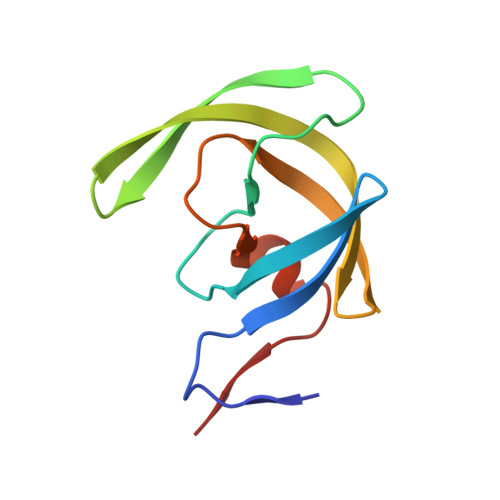Effect of the Active Site D25N Mutation on the Structure, Stability, and Ligand Binding of the Mature HIV-1 Protease.
Sayer, J.M., Liu, F., Ishima, R., Weber, I.T., Louis, J.M.(2008) J Biol Chem 283: 13459-13470
- PubMed: 18281688
- DOI: https://doi.org/10.1074/jbc.M708506200
- Primary Citation of Related Structures:
3BVA, 3BVB - PubMed Abstract:
All aspartic proteases, including retroviral proteases, share the triplet DTG critical for the active site geometry and catalytic function. These residues interact closely in the active, dimeric structure of HIV-1 protease (PR). We have systematically assessed the effect of the D25N mutation on the structure and stability of the mature PR monomer and dimer. The D25N mutation (PR(D25N)) increases the equilibrium dimer dissociation constant by a factor >100-fold (1.3 +/- 0.09 microm) relative to PR. In the absence of inhibitor, NMR studies reveal clear structural differences between PR and PR(D25N) in the relatively mobile P1 loop (residues 79-83) and flap regions, and differential scanning calorimetric analyses show that the mutation lowers the stabilities of both the monomer and dimer folds by 5 and 7.3 degrees C, respectively. Only minimal differences are observed in high resolution crystal structures of PR(D25N) complexed to darunavir (DRV), a potent clinical inhibitor, or a non-hydrolyzable substrate analogue, Ac-Thr-Ile-Nle-r-Nle-Gln-Arg-NH(2) (RPB), as compared with PR.DRV and PR.RPB complexes. Although complexation with RPB stabilizes both dimers, the effect on their T(m) is smaller for PR(D25N) (6.2 degrees C) than for PR (8.7 degrees C). The T(m) of PR(D25N).DRV increases by only 3 degrees C relative to free PR(D25N), as compared with a 22 degrees C increase for PR.DRV, and the mutation increases the ligand dissociation constant of PR(D25N).DRV by a factor of approximately 10(6) relative to PR.DRV. These results suggest that interactions mediated by the catalytic Asp residues make a major contribution to the tight binding of DRV to PR.
Organizational Affiliation:
Laboratory of Chemical Physics, NIDDK, National Institutes of Health, Bethesda, Maryland 20892-0520, USA.
















